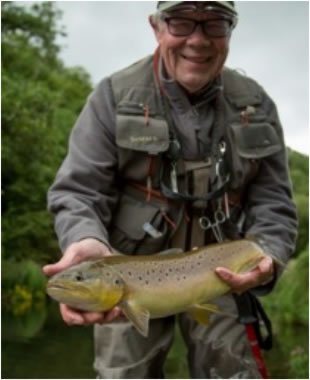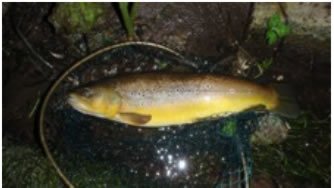Fishing Report – 16 August 2016
Despite its peaceful reputation, fly fishing can be a dangerous pastime. In my fishing career I’ve fallen in many times, had my boat sink under me, been stung, chased by bears and had undercut banks collapse on me. All these things and more can be viewed as occupational hazards, to be taken in one’s stride. Imagine then, a scene on the upper Wye one recent July day. You’re in Freddie’s addressing a rising fish, totally absorbed in the moment. An unusual mooing sound from high above on the crag distracts you momentarily, just as the fish takes the fly. Damn, missed it! And that’s the last thing you ever know as three quarters of a ton of beef crashes down on your head.
Fortunately, you weren’t fishing in Freddie’s on 17 July, otherwise it could have been you. John Frazer came upon this scene during an afternoon session between the Spit on the lake and Litton Mill. I know the rules ask members to inform the keepers of fallen stock but this was ridiculous! John, by the way, had a super session with over thirty fish, most to an Elk Hair Caddis.
When Tom Richardson was moving house recently he came across this old photo of the Locked Bridge taken from the true left bank. Is the man is the original Keeper Lupton with his son next to him? Lupton Jnr took over the job when his father retired and Tom succeeded Lupton Jnr . This bridge is obviously a predecessor to the one we replaced, which was a much more crude affair made of tree trunks.

The other noticeable feature is the lack of tree cover on the true right bank below the bridge. Don Stazicker was on hand to witness the capture of this superb brown trout by Mike
Hallam. Don had been filming rising trout taking duns, up from the New Bridge car park. He pointed out the most consistent riser to Mike, who promptly hooked it first cast with a CDC Olive. Measuring a good 20 inches, Don reckons it would have been around 3lbs. Mike also had a 17 inch rainbow to round off the evening. Needless to say, the beers were on him at the Cock & Pullet later.
After a two week break for family holidays I was desperate to get back on the river. Despite a threatening sky, I pitched up at Harry’s at around 6.30 pm. Walking down to Presidents I could see every stone on the bottom – it was going to be a challenging evening. I got in at the top of Presidents and carefully fished the run in. There was no sign of any fly life so I started to prospect with a CDC & Elk Caddis. I covered the deep hole carefully to no avail. Moving up into the pool behind the island, I saw a fish move on the far side of the current. Marking him down for my attention later, I began with the quiet water on my side. Kneeling down on the sandy bottom I spied another movement in the seam. I dropped the fly about a yard above and it was taken straight away. I swung the rod downstream to lead the fish away from the spot I’d seen the earlier rise. The fish was a wild rainbow of around a pound and it fought like hell on my replacement Sunray 2 weight (thanks Tom). This one needed the net. I shuffled on my knees a few feet further upstream and addressed the other riser. Holding the rod over the current, I let the fly dance on the surface as though I was fishing Tenkara style. This was too much for the fish and up came another rainbow, slightly smaller than the first but just as feisty. Harry’s produced a couple more wild rainbows, then I walked upstream to spend the last hour in Signposts. The water here was desperately thin and annoyingly, not only were those pesky geese in residence but a goosander was sitting right in the middle of the best hole. The geese did no worse than a bit of hissing as I fished past them but the goosander made a hell of a commotion as it left the pool. I made a few desultory casts thinking the bird must have cleaned the pool out, but not a bit of it. First cast produced a rise, which I missed, then two more rainbows followed in quick succession. It is important that members let the keepers know about any sawbills or cormorants seen on the river, and in particular let them have photos of any damaged fish. This is so that we can build up a body of evidence to support our application for a licence to cull these birds.
During the spell of hot weather I persuaded the Doctor to join me for the last hour in Monsal Dale. There were several fish showing as we sat watching the pool below the footbridge, biding our time. At length, the Doctor decided to go above the bridge, whilst I crept up on the risers in the broad pool. Most of the fish were concentrated on either side of the main current but one or two were showing in the slack water. These were quiet movements, suggesting spinners were on the menu. I had a choice of fish to aim for as the rise gathered momentum. Despite all this promising activity, my Parachute Spinner remained unmolested. I looked closely at the surface and sure enough there were spent spinners coming down. There were however BWO duns too. This was looking like a classic case of the fish concentrating on the dun rather than the spinner. Only one way to find out. A dun pattern was chosen, the next rise covered and a fish was on. Cracked it! Once it was to hand I pumped him out and he was full of spinners in the distorted shape imitated by Stuart’s Cranked Shank Spinner. So maybe I hadn’t cracked it after all. I switched back to the spinner and eventually hooked a couple more before the rise petered out. On reflection, I don’t think the pattern was to blame for my poor showing. I put it down to my lack of accuracy – fish on the fin high in the water just don’t see the fly unless it goes straight over their restricted window. When I eventually found the Doctor he’d also had three, but on a caddis.
A couple of evenings later I was back on the river, again for the last hour. I decided to give the Parachute Spinner another run, intending to switch to an Elk Hair Caddis later. As it turned out, I kept it on all evening and enjoyed one of the best sessions I’ve had in a long while. The fish came steadily to it all evening, capped
with wild browns of 3lbs 2oz and 1lb 14ozs in consecutive casts, just as the light was going. The big brownie is the best Wye fish I’ve ever had on a dry and it was accompanied by a fish of similar size during the fight. You’ll forgive me if I don’t tell you where I was!
I can’t quite believe that the season is drawing to a close. Some of the best fishing of the season is still before us, so let’s make the most of it!
Tight lines!
David Marriott




